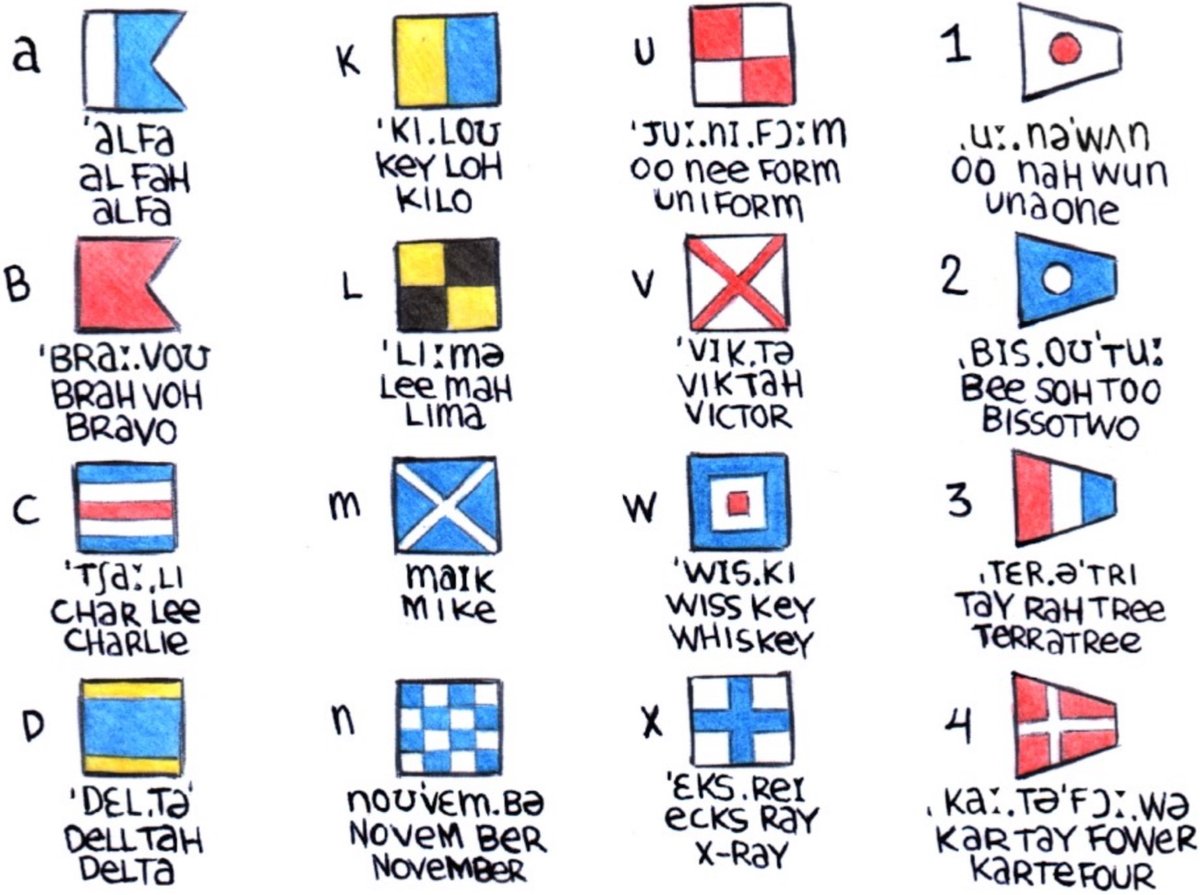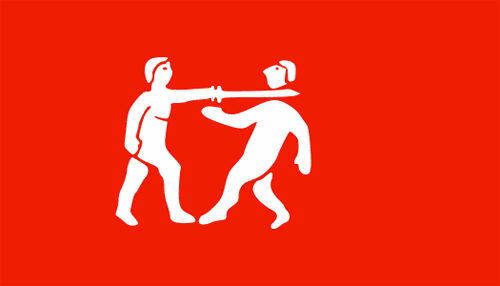
An illustrated and hand-lettered guide to the system of international maritime signal flags that are used to communicate when speaking is difficult (“because of language barriers, distance, etc….”)

See also hand flag semaphore and day shapes from the same creator.
According to Whose Heritage?, a report by the Southern Poverty Law Center on public symbols of the Confederacy, progress over the past two years on removing statues, flags, and other symbols from public places has been slow.
The 2015 massacre of nine African Americans at the historic “Mother Emanuel” church in Charleston sparked a nationwide movement to remove Confederate monuments, flags and other symbols from the public square, and to rename schools, parks, roads and other public works that pay homage to the Confederacy. Yet, today, the vast majority of these emblems remain in place.
In this updated edition of the 2016 report Whose Heritage?, the SPLC identifies 110 Confederate symbols that have been removed since the Charleston attack — and 1,728 that still stand.
Still very much standing, for instance, the Mount Rushmore of the Confederacy in Georgia, a massive stone carving featuring Jefferson Davis, Robert E. Lee and Thomas “Stonewall” Jackson.
And perhaps even worse, not represented on this map are Confederate symbols that are part of the official identities of many Southern states. Did you know Mississippi’s official state flag still contains the Confederate battle flag?

As of the 2010 Census, ~37% of Mississippi’s population is African American and due to the relative youth of the state’s African Americans and the wealth of the state’s whites (who are able to send their kids to private school), most of the state’s public schools are majority black. That percentage would be much higher had not so many African Americans left the state during the Great Migration. The pledge to this flag, which is taught in public schools, reads “I salute the flag of Mississippi and the sovereign state for which it stands with pride in her history and achievements and with confidence in her future under the guidance of Almighty God.” Could you imagine being the descendant of a former slave being made to pledge allegiance to a symbol used by people who fought a war to deny the personhood of your ancestors?
Mississippi’s flag contains the most familiar reference to the Confederacy, but many other state flags have Confederate references. Georgia’s flag contained the Confederate battle flag from 1956 to 2003 and the current flag is modeled after the first national flag of the Confederacy. The flags of Florida and Alabama contain St. Andrew’s Crosses, thought to be references to the stars and bars of Confederate battle flag. The Arkansas state flag contains four stars on a white background, one of which represents the Confederacy, along with a deconstructed stars and bars pattern. North Carolina’s flag is based on a design adopted shortly after the state seceded from the United States. Residents of many states can also get official state license plates with Confederate symbols on them and some state seals have Confederate references.
Lots of progress still to go on that journey towards a post-racial America I guess…
Update: A new Confederate monument was just erected last week near Mobile, Alabama. Here’s what the plaque says about the Confederacy:
The northern Union aggressively prosecuted its war to subjugate the Confederate States. Union forces continued invading and waging war in the field, on cities, and on homesteads in the Confederacy causing more American deaths in both countries than the combined totalitarian regimes of the twentieth century. About two-thirds of these deaths were Union military sent to kill Confederate Americans. The Union’s army was about 3 times larger and it possessed about 20 times the industrial arms capacity of the CSA. It succeeded in militarily prevailing over the Confederate forces after four years. The last major land battle occurred in April of 1865 here and at Ft. Blakeley. The elected government of the CSA was scattered, the American States of that country occupied by northern forces, and the citizens’ rights suppressed.
In April 1865, the Union President was shot watching a comedy play in his capitol of Washington City — almost exactly four years after he sent his warships into the CSA initiating the War Between the States. The Confederacy’s President was seized and imprisoned in May 1865 after he had to flee his capitol of Richmond, Virginia, due to the approach of invading Union forces.
For many, the Civil War never quite ended.
Atop the South Carolina statehouse, both the national and state flags flew at half mast yesterday. But not the Confederate Flag. The symbolic reasons loom large. The literal reason was uncovered by a reporter.
The flag is part of a Confederate War Memorial, and is not on a pulley system, so it cannot be lowered, only removed.
That actually sounds like an ideal solution. In The Atlantic, Ta-Nehisi Coates argues we should take down the Confederate Flag.
That the Confederate flag is the symbol of of white supremacists is evidenced by the very words of those who birthed it.

MoMA has announced that they’ve acquired the Rainbow Flag for their permanent collection. The flag has been a symbol of the LGBT community around the world since its creation in 1978. As part of the acquisition, MoMA Curatorial Assistant Michelle Millar Fisher interviewed the man who designed the flag, artist Gilbert Baker.
And I thought, a flag is different than any other form of art. It’s not a painting, it’s not just cloth, it is not a just logo — it functions in so many different ways. I thought that we needed that kind of symbol, that we needed as a people something that everyone instantly understands. [The Rainbow Flag] doesn’t say the word “Gay,” and it doesn’t say “the United States” on the American flag but everyone knows visually what they mean. And that influence really came to me when I decided that we should have a flag, that a flag fit us as a symbol, that we are a people, a tribe if you will. And flags are about proclaiming power, so it’s very appropriate.
So the American flag was my introduction into that great big world of vexilography. But I didn’t really know that much about it. I was a big drag queen in 1970s San Francisco. I knew how to sew. I was in the right place at the right time to make the thing that we needed. It was necessary to have the Rainbow Flag because up until that we had the pink triangle from the Nazis — it was the symbol that they would use [to denote gay people]. It came from such a horrible place of murder and holocaust and Hitler. We needed something beautiful, something from us. The rainbow is so perfect because it really fits our diversity in terms of race, gender, ages, all of those things. Plus, it’s a natural flag — it’s from the sky! And even though the rainbow has been used in other ways in vexilography, this use has now far eclipsed any other use that it had…
Update: Baker died at his home on March 30, 2017. He was 65 years old.
Mr. Baker replicated his flag dozens of times over the years. He crafted a mile-long banner to parade down Fifth Avenue in Manhattan, and he sent flags around the world in support of gay rights protests. He sewed the rainbow flag used in the movie “Milk,” along with a new flag for this year’s television miniseries “When We Rise.”
“I remember the most fabulous queen I’d ever seen in my life shows up in sequins with a sewing machine in his arms, and he insisted on creating that flag exactly the same way he’d created it then,” said Dustin Lance Black, who wrote “Milk” and wrote and directed “When We Rise,” which was based on Jones’ memoir of the same name.
What the world needs is a great flag, a flag of pure bliss. Here’s one of the intermediate steps to the finished product; it’s an average of all the world’s countries’ flags weighted by population.

Ted Kaye has compiled some advice for designing flags.
1. Keep it simple.
2. Use meaningful symbolism
3. Use 2-3 basic colors
4. No lettering or seals
5. Be distinctive or be related
In a nutshell:
The flag should be so simple that a child can draw it from memory.
The best flag in the world follows all of these rules.

That’s the flag of the Benin Empire, a pre-colonial African state situated in modern Nigeria that lasted from 1440 until 1897. (via andre)
Pie charts representing the flags of the world’s nations…the area of each color on the charts corresponds to the percentage of that color used in the respective flag. I’ll take this opportunity to again maintain that Rem Koolhaas’ barcode flag for the EU is, technically speaking, wicked awesome. (via colourlovers)











Stay Connected